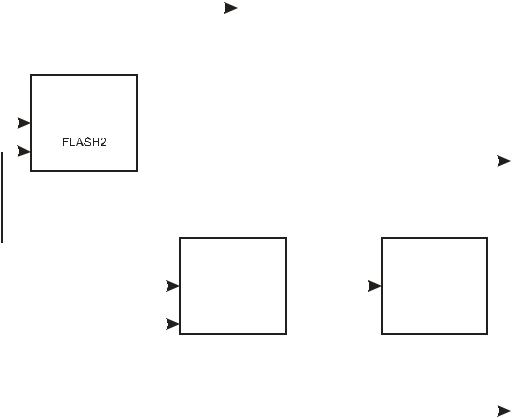
- •Contents
- •About Getting Started Modeling Processes with Solids
- •Why Use Solids Simulation?
- •Sessions in this Book
- •Using Backup Files
- •Related Documentation
- •Installation Manual
- •User Guide
- •Technical Support
- •World Wide Web
- •Hours
- •Modeling Coal Drying
- •Coal Drying Flowsheet
- •Drawing the Graphical Simulation Flowsheet
- •Stream Classes and Substreams
- •Specifying Components
- •Defining Properties
- •For More Information on the HCOALGEN Model
- •Entering Stream Data
- •Specifying Blocks
- •Using a Calculator Block to Control Drying
- •Running the Simulation
- •Examining Simulation Results
- •Exiting Aspen Plus
- •Modeling Coal Combustion
- •Coal Combustion Flowsheet
- •Starting Aspen Plus
- •Opening an Existing Run
- •If Your Saved File Solid1.apw is Not Displayed
- •Saving a Run Under a New Name
- •Drawing the Graphical Simulation Flowsheet
- •Changing the Stream Class
- •Adding Components to the Model
- •Defining Properties
- •Change the Heat of Combustion Method for Coal
- •Specify the Heat of Combustion for Coal
- •Specifying the Air Stream
- •Specifying Unit Operation Models
- •Specify the Splits for the SSplit Block
- •Defining a Calculator Block
- •Specify the Calculations to be Performed
- •Specify When the Calculator Block Should be Run
- •Running the Simulation
- •Examining Results
- •Exiting Aspen Plus
- •Modeling Gas-Solid Separators
- •Gas-Solid Separation Flowsheet
- •Starting Aspen Plus
- •Opening an Existing Run
- •If Your Saved File Solid2.apw is Not Displayed
- •Saving a Run Under a New Name
- •Drawing the Graphical Simulation Flowsheet
- •To Update the Title for This Simulation
- •Running the Simulation
- •Examining Results
- •Exiting Aspen Plus
- •Modeling Polymer Recovery
- •Polymer Recovery Flowsheet
- •Starting Aspen Plus
- •To Specify the Application Type and Run Type for the New Run
- •Drawing the Graphical Simulation Flowsheet
- •Specifying Components
- •Defining Properties
- •Defining Stream Conditions
- •Entering Block Specifications
- •Enter Specifications for the CCD Model
- •To Learn More about the Cyclone Model Using Help
- •Enter Specifications for the Cyclone Model
- •To Specify That the Mixer Block DRIER Operates at 15 psi
- •Enter Specifications for the HyCyc Model
- •Running the Simulation
- •Examining Results
- •Exiting Aspen Plus
- •Connecting to the Aspen Plus Simulation Engine

Modeling Coal Combustion
In this simulation, you will simulate a coal combustion process.
You will:
•Start with the simulation you created in Simulation 1
•Modify the flowsheet
•Change the default stream class
•Add the components needed for combustion
•Specify the unit operation models
•Define a Fortran block to control the decomposition of coal
•Analyze the results
Allow about 45 minutes to complete this simulation.
Getting Started - Solids |
Modeling Coal Combustion • 3-1 |

Coal Combustion Flowsheet
The process flow diagram, operating conditions and problem definition for this simulation are shown in the following figure. The feed to the furnace is the dried coal stream from Simulation 1. After combustion, the ash is separated from the gaseous combustion products.
|
|
|
|
|
|
EXHAUST |
|
|
|
|
||
Temp = 77 F |
|
|
|
|
|
|
|
|
|
|||
Pres = 14.7 PSI |
|
|
|
|
|
|
|
|
|
|||
Coal Flow = 10000 lb/hr |
|
|
|
|
|
|
|
|
|
|||
Water Content = 25 wt% |
DRIER |
|
|
|
|
|
|
|
||||
WET COAL |
Isobaric |
|
|
|
|
|||||||
|
|
|
|
|
|
|||||||
|
|
|
|
|
|
Adiabatic |
|
|
GASES |
|||
|
|
|
|
|
DRY COAL |
|
|
|||||
|
|
|
|
|
|
|||||||
|
|
|
|
|
|
|
|
|
||||
|
|
|
|
|
|
|
|
|
||||
|
|
|
|
|
Water Content = 10 wt% |
|
|
|
|
|||
NITROGEN |
|
|
|
|
|
|
|
|
|
|||
|
|
|
|
|
|
|
|
|
|
|
|
|
Temp = 270 F |
|
|
|
BURN |
|
SEPARATE |
||||||
Pres = 14.7 PSI |
|
|
|
PRODUCTS |
||||||||
Mass Flow = 50000 lb/hr |
|
|
|
|
|
|
Perfect |
|||||
|
|
|
|
|
|
|
separation |
|||||
Mole Fraction N2 = 0.999 |
|
|
|
|
|
|
|
|||||
|
|
|
RGIBBS |
|
SSPLIT |
|||||||
Mole Fraction O2 = 0.001 |
|
|
|
|
||||||||
|
|
|
|
|
|
|
|
|
||||
Temp = 77 F |
|
|
|
Isobaric |
|
|
|
|
||||
|
|
|
|
|
|
|
||||||
|
|
|
|
|
|
|
||||||
Pres = 14.7 PSI |
|
|
|
|
|
|||||||
|
Adiabatic |
|
|
|
|
|||||||
Mass Flow = 90000 lb/hr |
|
|
|
|
|
|||||||
|
|
|
|
|
|
|
||||||
Mole Fraction N2 = 0.79 |
|
|
|
|
|
|
|
|||||
Mole Fraction O2 = 0.21 |
|
|
|
|
|
SOLIDS |
||||||
|
|
|
|
|
|
|
|
|
|
|
||
AIR |
|
|
|
|
|
|
|
|
|
|||
|
|
|
|
|
|
|
|
|
||||
Starting Aspen Plus
1From your desktop, select Start and then select Programs.
2Select AspenTech | Aspen Engineering Suite | Aspen Plus 11.1 | Aspen Plus User Interface.
The Aspen Plus Startup dialog box appears.
3-2 • Modeling Coal Combustion |
Getting Started - Solids |
